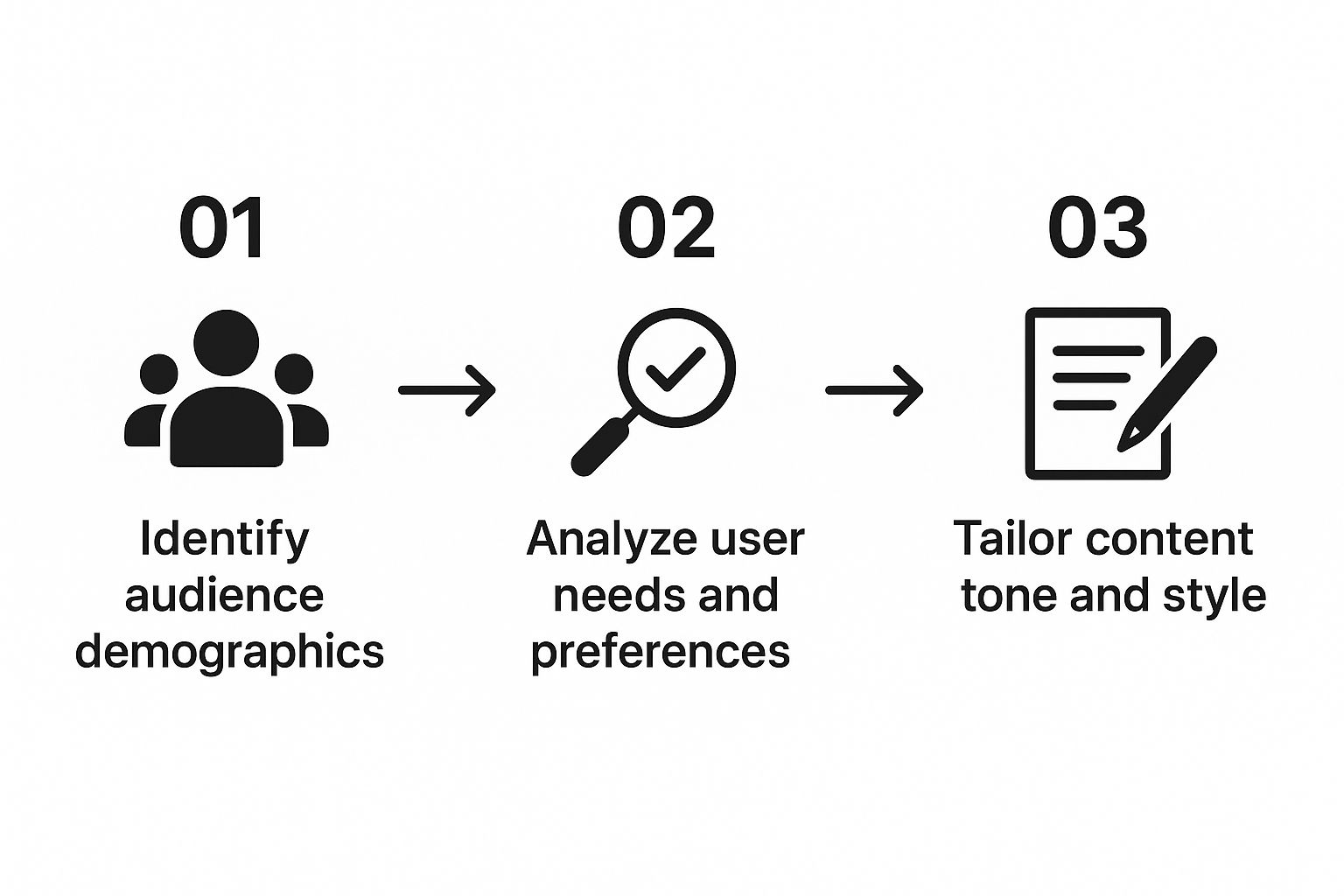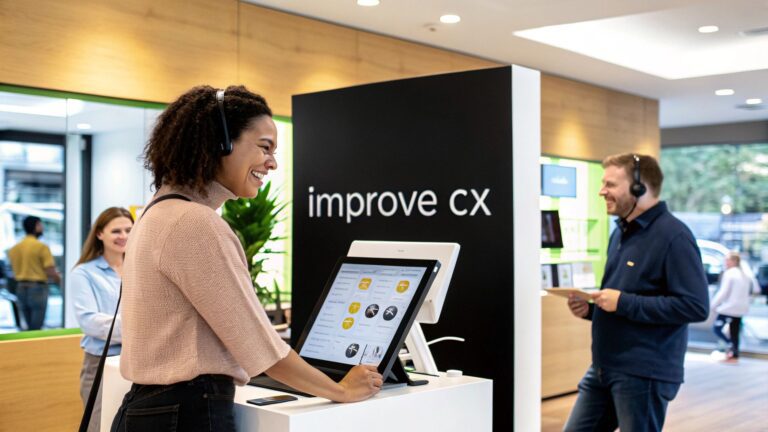Great website content doesn't just happen; it's meticulously planned. Before you write a single word, you need to dig deep into your audience, scout out the competition, and get your ideas structured. This upfront work is what makes the difference between content that disappears and content that gets results.
Build Your Content Foundation Before You Write
Jumping straight into writing without a plan is like building a house without a blueprint. Sure, you might end up with four walls and a roof, but it probably won’t be the sturdy, functional home you envisioned. The best website content—the stuff that actually attracts, engages, and converts—is always built on a solid strategic foundation. This first phase is about deep thinking, not fast typing.
Before you even dream of a catchy headline, you have to get inside your audience's head. Who are you actually trying to reach? What are their biggest headaches? What problem are they desperately trying to solve when they land on your site? Pumping out generic content for a faceless crowd is the fastest way to get ignored.
Define Your Ideal Reader
Your first job is to paint a crystal-clear picture of your ideal reader. This goes way beyond basic demographics like age and location; you need to understand their mindset.
- Pinpoint Their Frustrations: Get specific about the pain points your product or service solves. A plumber, for instance, isn't just writing for "homeowners." They're writing for a person panicking about a burst pipe or someone feeling anxious about the cost of replacing their boiler.
- Map Their Goals: What is their ultimate goal? Think of your content as the roadmap that helps them get from where they are to where they want to be.
- Anticipate Their Questions: Good content answers the questions people are already typing into Google. Truly brilliant content answers the follow-up questions they haven't even thought of yet.
This is all about tailoring your message so it lands perfectly.

Ultimately, understanding your audience is what dictates your tone and style, making sure your message actually connects.
Analyse the Competitive Landscape
Right, so you know who you’re talking to. Now it's time to see what they're already reading. A competitive analysis isn't about stealing ideas; it's about spotting gaps and finding opportunities to create something far better.
Go ahead and search for your main topics. Open up the top-ranking pages and really dissect them. Ask yourself a few key questions:
- What are they explaining really well?
- What crucial information have they completely missed?
- Could I explain this in a simpler, more practical way?
- Are their examples or stats starting to look a bit dated?
Your mission is to create content that is demonstrably better than what's already out there. This could mean going more in-depth, offering a fresh perspective, or providing advice that people can actually use. You want to create the go-to resource on the topic.
This is particularly important in a market as connected as the UK. Think about it: as of January 2025, an incredible 97.8% of the UK population were active internet users. With nearly everyone online, your content has to be exceptionally clear and relevant to cut through the noise and grab the attention of a very digitally-savvy audience.
To really get the most out of your efforts, you need to see how each piece of content fits into your wider full-funnel marketing strategy. This perspective ensures everything you publish has a purpose, whether it's attracting brand-new visitors, nurturing potential leads, or helping to close a sale. When you align your content with a bigger plan, you stop just writing articles and start building a powerful business asset.
Mastering the Art of Compelling Website Copy

Right, you’ve got a solid plan. Now it’s time to turn that strategy into words that genuinely connect with people. This is where the magic really happens—transforming all that research and outlining into copy that guides, informs, and ultimately persuades.
First things first: forget stuffy, corporate speak. Modern website content needs to feel human. The goal is to write in a way that feels less like a sales pitch and more like a helpful conversation. You want your reader to feel seen and understood, not talked at. That means dropping the jargon, keeping things simple, and focusing on clarity above all else.
Craft Headlines That Are Impossible to Ignore
Your headline is your first, and sometimes only, chance to make an impression. Let's be honest, attention spans are shorter than ever. A weak headline means your carefully crafted content goes unread. It needs to be magnetic.
A great headline does two things straight away: it grabs attention and it makes a clear promise about the value the reader is about to get. Think about the core question your content answers and frame your headline around that solution.
- Be Specific and Benefit-Driven: Instead of a vague title like "Our New Services," try something like "Fast and Reliable IT Support for Norfolk Businesses." The second option immediately tells the reader who it's for and what the main benefit is. It’s direct and powerful.
- Use Numbers and Data: There's a reason why list-based posts are so popular—they work. "5 Ways to Improve Your Website Security" is far more compelling than "Improving Your Website Security." Numbers create a sense of structure and a finite commitment for the reader. They know exactly what they're getting into.
Think of your headline as the front door to your content. If it isn't inviting, nobody is coming inside.
Hook Readers From the Very First Sentence
Once you’ve earned the click with a killer headline, your opening paragraph has to deliver. This is your hook. You have about three seconds to convince the reader that they've landed in the right place and that sticking around is worth their time.
The best way to do this is by directly addressing their problem or question. Show a bit of empathy and let them know you understand their challenge. It builds an instant connection.
The most effective opening hooks don't just state the topic; they agitate the problem. They remind the reader of their frustration, making the solution you're about to offer feel that much more valuable and urgent.
For example, if you're writing about eCommerce development, you could open with: "Struggling to turn website visitors into actual customers? It's a common frustration when your online shop just isn't built to convert." This validates the reader's experience and dangles the promise of a solution.
Find and Maintain Your Authentic Brand Voice
How you say something is just as important as what you say. Your brand voice is the distinct personality your business has in its writing. Are you professional and authoritative? Friendly and witty? Inspiring and encouraging?
Whatever you choose, consistency is everything. An inconsistent voice can confuse your audience and damage trust. A customer who enjoys a helpful, friendly blog post will be put off if your service page is suddenly filled with cold, technical jargon.
Here’s a simple way to pin down your voice:
- Describe your brand in three words: If your brand were a person, what would they be like? Helpful, expert, straightforward?
- Think about your audience: Write in a way that will actually resonate with the people you’re trying to reach. A B2B IT solutions provider is going to have a very different voice from a local bakery.
- Create a simple style guide: Note down some basic "do's and don'ts." For instance: Do use contractions like "it's" and "we'll." Don't use overly formal language like "henceforth" or "utilise."
Developing a strong, consistent voice is a cornerstone of any successful website content strategy, as it turns simple text into a memorable brand experience.
Write for Clarity and Scannability
Let's face it: people don't read websites, they scan them. Your job is to make your content as easy to digest as possible for busy people, often scrolling on their phones. Dense walls of text are an immediate turn-off.
Break up your writing with smart formatting to make it easy on the eyes.
- Keep Paragraphs Short: Aim for one to three sentences per paragraph, maximum. This creates plenty of white space and makes the page feel less intimidating.
- Use Descriptive Subheadings: Use H2 and H3 headings to chop your content into logical, bite-sized sections. This helps readers find exactly what they're looking for without having to read every word.
- Embrace Bullet Points: Use bulleted and numbered lists (like this one!) to present information in a highly scannable format. They are perfect for laying out steps, features, or benefits.
Website Content Format Effectiveness in the UK
Different content formats serve different purposes, from building trust with in-depth guides to capturing attention with video. Based on market data from 2025, here's a look at what UK businesses are using and why.
| Content Format | Percentage of UK Businesses Using | Primary Goal |
|---|---|---|
| Blog Posts / Articles | 85% | SEO, Thought Leadership, Trust |
| Case Studies | 62% | Social Proof, Conversion |
| Video Content | 58% | Engagement, Brand Awareness |
| Infographics | 45% | Data Visualisation, Shareability |
| eBooks / Whitepapers | 33% | Lead Generation, Authority |
As the data shows, traditional blog posts remain the workhorse of content strategy for their SEO benefits. However, a mix of formats, especially visual ones like video and infographics, is crucial for engaging a modern audience.
By writing with clarity and scannability in mind, you respect your reader's time and drastically increase the chances that your core message will actually land.
Weaving SEO Naturally Into Your Content

You can write the most compelling website content in the world, but if nobody can find it, it might as well not exist. This is where search engine optimisation (SEO) comes in, but let's be clear: this isn't about cramming keywords into sentences until they sound like they were written by a robot.
Modern SEO is far more sophisticated. It’s about creating high-quality, genuinely valuable content that naturally includes the words and phrases people are actually using to find answers. The goal is to write for your human audience first, but in a way that gives search engines every possible signal that your page is the best result for what they’re looking for.
Thinking Beyond Single Keywords
In the early days of the internet, SEO was often a crude game of repeating a single keyword as many times as you could get away with. Thankfully, those days are long gone. Search engines are now incredibly smart and focus on something called semantic search, meaning they understand the context and intent behind a search, not just the individual words.
This is brilliant news for anyone creating content. It means your focus should be on covering a topic from every angle. When you do this, you'll find you naturally use a wide range of related terms and phrases.
For example, if your main topic is "small business IT support," a truly helpful article will inevitably touch on related concepts like:
- Remote assistance for companies
- Cybersecurity for SMEs
- Microsoft 365 setup
- Data backup solutions
- Network troubleshooting
These related terms are what some people call Latent Semantic Indexing (LSI) keywords. You don't need to hunt for a specific list; just concentrate on writing the most helpful, in-depth piece you can. By covering all the relevant sub-topics, you naturally signal your expertise to search engines.
The core principle is simple: write for the human reader. When you thoroughly answer their questions and cover a topic from all angles, you are inherently optimising your content. It's about demonstrating authority, not just repeating phrases.
The On-Page Essentials That Matter
While comprehensive writing is the foundation, a few practical on-page elements are crucial for telling search engines exactly what your content is about. Getting these right can make a real difference.
Meta Titles and Descriptions
Your meta title (or title tag) is the blue clickable link you see in search results, and the meta description is the short snippet of text beneath it. They don't have a massive direct impact on rankings, but they have a huge impact on whether someone actually clicks on your link.
Think of them as your content's little advert on the search results page.
- Meta Title: Make it clear, compelling, and include your primary keyword. Aim for under 60 characters to stop it from being cut off. For instance, "Expert IT Support for Norfolk Businesses | Ibertech Solutions" is direct and informative.
- Meta Description: This is your chance to sell the click. Summarise the page's value and include a call to action. Keep it to around 155-160 characters. A good example: "Get fast, reliable IT support for your Norfolk business. Our experts offer remote and on-site help to keep you running smoothly. Find out more."
A Logical Heading Structure
Headings (H1, H2, H3, and so on) are vital. They create a logical structure that helps both readers and search engines scan your content and understand its hierarchy.
Your main page title should always be your one and only H1 tag. Major sub-topics should be H2s, and any points within those sections can be H3s. Weaving your primary and secondary keywords into these headings is a powerful way to signal relevance. Our guide on how to rank higher on Google explores these structural elements in more detail.
Optimising Image Alt Text
Alt text (alternative text) is a short, written description of an image. Its main purpose is for screen readers used by visually impaired users, but search engines also use it to understand what an image depicts.
Every single image on your page should have descriptive alt text. Instead of a generic filename like "image123.jpg," use something that explains the picture, like "IT technician helping a small business owner with their laptop." It’s better for accessibility and a simple but effective SEO win.
Using Visuals to Boost Engagement and Retention

Let’s be honest: in today's digital world, a wall of text just won't cut it. Our brains are wired to process images thousands of times faster than words, so using visuals isn't just a nice design choice—it's a critical part of keeping your readers hooked.
Breaking up your content with well-chosen images, videos, or graphics makes it far easier to read and scan. More importantly, it helps illustrate complex ideas and creates a much more dynamic experience. This has a direct impact on metrics that search engines care about, like dwell time. The longer someone stays on your page, the clearer the signal to Google that your content is hitting the mark.
Choosing the Right Visuals for the Job
Not all visuals are created equal. The goal is to find assets that genuinely add value and support your message, not just fill empty space.
- High-Quality Photography: Forget generic stock photos. Authentic, high-resolution pictures of your team, your products in use, or your customers build a level of trust that stock imagery simply can't match.
- Custom Infographics: These are absolute gold for turning complex data, statistics, or processes into something digestible and shareable. A good infographic tells a story with data.
- Engaging Video: Short-form video is a powerhouse for grabbing attention. Think quick tutorials, product demonstrations, or even a short clip from a client testimonial.
This isn't just a hunch; it's what the data shows across the UK market. By 2025, a huge 72% of UK businesses will be using content marketing, with images and short-form video being the most popular formats, used by 50% of businesses. The trend is crystal clear: audiences connect with visual content.
Visuals do more than just make your page look good. They break down walls of text, improve comprehension, and can make your content up to 80% more memorable. An article with relevant images gets significantly more views than one without.
Practical Tips for Sourcing and Creating Visuals
You don’t need a massive budget or an in-house design team to make this happen. There are plenty of fantastic, accessible tools out there.
When it comes to sourcing images, platforms like Unsplash or Pexels offer massive libraries of high-quality, royalty-free photos. That said, nothing beats your own photography for authenticity.
For creating custom graphics or infographics, user-friendly tools like Canva have completely changed the game. You can jump in with their templates and quickly produce professional-looking visuals that align with your brand's colours and style.
For any business selling online, strong visuals are a cornerstone of successful eCommerce conversion rate optimisation. Think about it—great product photography and videos can be the final nudge a customer needs to click "buy".
Ultimately, weaving a smart visual strategy into your content creation process transforms a simple page of text into a rich, memorable experience. It keeps your reader engaged and makes your content far more likely to be shared and remembered.
The Final Polish Before You Publish
So, you’ve typed the final full stop. Job done, right? Not quite. What you do next is often the difference between content that’s just good and content that’s genuinely great. This is the spit-and-polish phase, where you refine your draft until it’s sharp, professional, and perfectly tuned for your audience.
I like to think of a first draft as a rough cut of a film. All the key scenes are there, but it’s the meticulous editing—the trimming, the re-ordering, the sound mixing—that turns it into a blockbuster. This final check is about much more than just catching typos; it's about sharpening your message and making every word count.
Create a Practical Editing Checklist
Relying on your word processor’s spell checker is simply not enough. A clean, error-free article shows you respect your reader's time and take your work seriously. But a proper edit goes much deeper, focusing on the rhythm and flow of your writing.
One of the best tricks I’ve learned is to read your work aloud. It might feel a bit odd at first, but it's the quickest way to spot clunky sentences, awkward phrasing, and repetitive rhythms that your eyes just glide over.
Your checklist should cover a few key areas:
- Clarity and Flow: Does each paragraph lead naturally to the next? Are your transitions smooth, or do they feel abrupt?
- Conciseness: Are you using ten words when five would do the job? Be ruthless. Hunt down and eliminate waffle, filler words, and unnecessary jargon.
- Active Voice: Look for passive sentences like, "The content was written by our team." Flip them into the active voice: "Our team wrote the content." It's far more direct and engaging.
- Consistent Tone: Does your tone of voice stay consistent from the introduction to the conclusion?
Think of meticulous editing as your content's quality control. It guarantees that the value you worked so hard to build is delivered clearly and professionally, building trust with every sentence.
Run Your Final Pre-Publish Checks
Before you even think about hitting that publish button, there are a few final technical and strategic checks to tick off. This is all about setting your content up for success, both for your readers and for search engines.
First up, double-check every single link. Do your internal links actually go to the right pages on your site? Do your external links open in a new tab, so you aren't sending people away from your website? Broken links are frustrating for users and can be a red flag for SEO.
Next, take a hard look at your call-to-action (CTA). Is it blindingly obvious what you want the reader to do next? Whether it’s "Contact Us Today," "Download Your Free Guide," or "Learn More About Our Services," your CTA needs to be clear and compelling.
Make Sure It Looks Great on Every Device
Finally, preview your post everywhere. How does it look on a huge desktop monitor? More importantly, how does it look on a mobile phone? With so much traffic coming from mobile devices, you can't afford to have a poor experience on smaller screens. Check that your images load properly, the text is easy to read, and all your formatting holds up.
This level of detail might feel small, but it’s a crucial part of creating website content that actually performs. The content world is incredibly competitive. The average blog post length has ballooned to around 1,427 words in 2025, which is over 70% longer than it was a decade ago. Longer content means more room for error and a greater need for that final polish.
On top of that, getting backlinks is a massive challenge, with research showing that a staggering 94% of blog posts earn zero backlinks. Polished, professional, and genuinely helpful content is far more likely to be seen as a credible source worth linking to. You can dig into more statistics on content marketing trends to get a better sense of the playing field.
Got Questions About Your Website Content?
As you get stuck into writing for your website, you're bound to run into a few tricky questions. This is where a bit of practical experience comes in handy. I’ve put together some straightforward answers to the questions I hear most often from writers and business owners.
Getting these details right can be the difference between a piece of content that gets found and one that just sits there. Let's dig into some of the big ones.
How Long Should My Website Content Be?
This is the classic question, and the only honest answer is: it really depends on what you're writing about and who you're writing for. There's no magic number that fits all.
Instead of obsessing over word count, shift your focus to giving the reader everything they need. A good question to ask yourself is, "If someone searches for this, what will leave them feeling like they've found the perfect answer?"
Here’s a more practical way to approach it:
- Pillar Pages: When you're tackling a big, competitive topic like "A Guide to Digital Marketing," you'll need to go deep. Think 2,000 words or more to properly cover all the ground.
- Specific Blog Posts: For a more focused subject, say "How to Write a Meta Description," you can usually be thorough in 1,000 to 1,500 words without waffling.
- Service Pages: These need to be punchy and persuasive. Aim for somewhere between 400 and 800 words. The mission here is to convince, not to write an encyclopaedia.
A great rule of thumb is to simply look at what’s already ranking. Search for your target keyword and see how long the top three results are. If they're all hefty 2,500-word articles, your 500-word post probably won't stand a chance.
Should I Just Delete Old, Outdated Content?
Hold on a minute! Hitting the delete button should be your absolute last resort. Even if an old post isn't bringing in much traffic, it's probably collected a little bit of SEO value and maybe even a backlink or two over the years. Deleting it means throwing all that away.
A far better move is to refresh and republish it. Go back in, update the stats and information, tighten up the writing, and give it a fresh coat of SEO paint.
A content refresh is a brilliant idea for any article that is:
- Outdated: Full of old data, broken links, or advice that's no longer relevant.
- Underperforming: It used to do well but has dropped off, or maybe it never really took off at all.
- A bit thin: It's a short piece on a good topic that could easily be expanded into a much more valuable guide.
This process gives your existing content a new lease of life and often gets results much quicker than starting from scratch.
How Often Should I Be Publishing New Content?
Here's the truth: consistency will always beat frequency. One brilliant, well-researched article a week is worth far more than five rushed, mediocre posts. Both your readers and the search engines will reward you for quality and reliability.
For most small or medium-sized businesses, a sustainable and effective schedule looks something like this:
- Publish one really solid blog post every week or two.
- Keep your main service pages and homepage updated as needed.
- Set aside time each quarter to review and refresh your ten oldest or worst-performing posts.
The key is to find a rhythm you can maintain without your standards slipping. Trying to publish daily often leads to burnout and poor-quality work that doesn't help anyone. Find a sustainable pace that lets you create your best work, every single time.
Ready to transform your website with content that attracts, engages, and converts? Ibertech Solutions Limited offers expert web design, SEO, and content strategy services to help your Norfolk or Suffolk business thrive online. Let's build a powerful digital presence together. Visit us at https://www.ibertechsolutions.co.uk to learn more.





